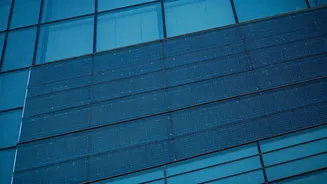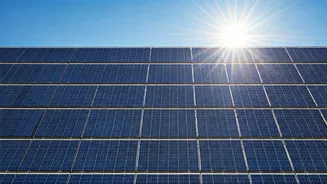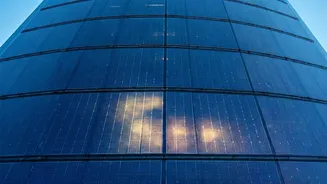Energy Generation Redefined
The conventional view of solar panels is rapidly changing, ushering in an era of semi-transparent solar cells. These cells, unlike their opaque counterparts,
allow light to pass through, opening up a plethora of design possibilities. This technological leap enables the integration of solar power into architectural elements like windows and building facades. The technology leverages advanced materials and innovative designs that capture solar energy while maintaining transparency. The shift promises a cleaner, more sustainable energy future by converting sunlight into electricity using surfaces that are already part of the building's structure. This eliminates the need for additional, space-consuming installations and aesthetically integrates renewable energy into the built environment.
How It Works
The operational principle of semi-transparent solar cells is based on the interaction of light with specialized materials. The technology relies on thin films of photovoltaic materials that are deposited onto transparent substrates. These films absorb a portion of the incoming sunlight, generating electricity in the process. The transparency is achieved by carefully controlling the thickness and composition of these films, as well as the arrangement of the semiconductor materials. By optimizing these parameters, researchers can fine-tune the balance between light transmission and energy conversion efficiency. The result is a glass surface that allows daylight to pass through while concurrently generating electrical power. This innovative approach signifies a fundamental shift in how we approach renewable energy integration in urban and residential areas, offering a dual benefit of aesthetic appeal and functionality.
Potential Applications
The applications for semi-transparent solar cells are vast and varied. Buildings can now incorporate solar energy seamlessly into their designs. Windows, skylights, and even entire facades can become power-generating elements, reducing reliance on conventional energy sources and decreasing carbon footprints. Furthermore, these cells can also be applied to vehicles, electronics, and various other surfaces where transparency is desired. The ability to integrate solar technology into existing infrastructure is a game-changer. It unlocks the potential for generating clean energy in locations and settings that were previously unfeasible. This paves the way for a more sustainable future, where renewable energy is ubiquitous and integrated with our daily lives, changing the way we perceive and use energy sources.
Breaking Records
Recent breakthroughs have marked significant milestones in the development of semi-transparent solar cells. Scientists have been working towards improving efficiency and reducing the costs associated with these cells. Research teams are persistently pushing the boundaries of what’s possible. They are exploring new materials and manufacturing techniques to enhance performance and make these cells more accessible. Progress in this field has led to record-breaking efficiencies in converting sunlight into electricity. These achievements not only demonstrate the technological potential of semi-transparent solar cells but also validate the efforts of researchers and engineers. The progress fuels optimism about a future where energy generation is more integrated into our surroundings, contributing significantly to sustainability.
Challenges Ahead
Despite the significant advancements, there are still challenges to overcome. Improving the efficiency of semi-transparent solar cells remains a primary focus. Researchers are working to increase the amount of sunlight converted into electricity while preserving transparency. Another area of focus is the cost-effectiveness of production. Making these cells affordable is crucial for their widespread adoption. Durability is another important consideration. Ensuring that these cells can withstand environmental factors and maintain their performance over time is essential. Furthermore, the integration of these cells into existing infrastructure requires careful planning and engineering. Addressing these challenges is pivotal for realizing the full potential of semi-transparent solar cells and accelerating the transition to a sustainable energy future.











